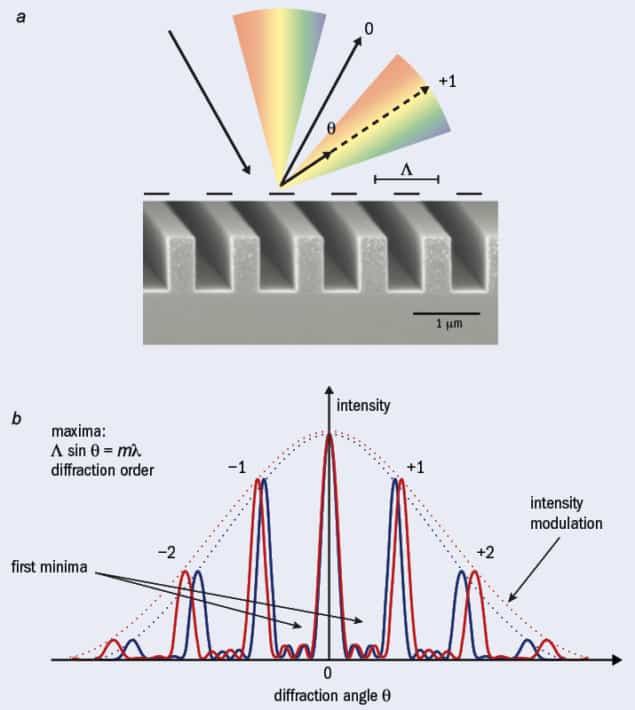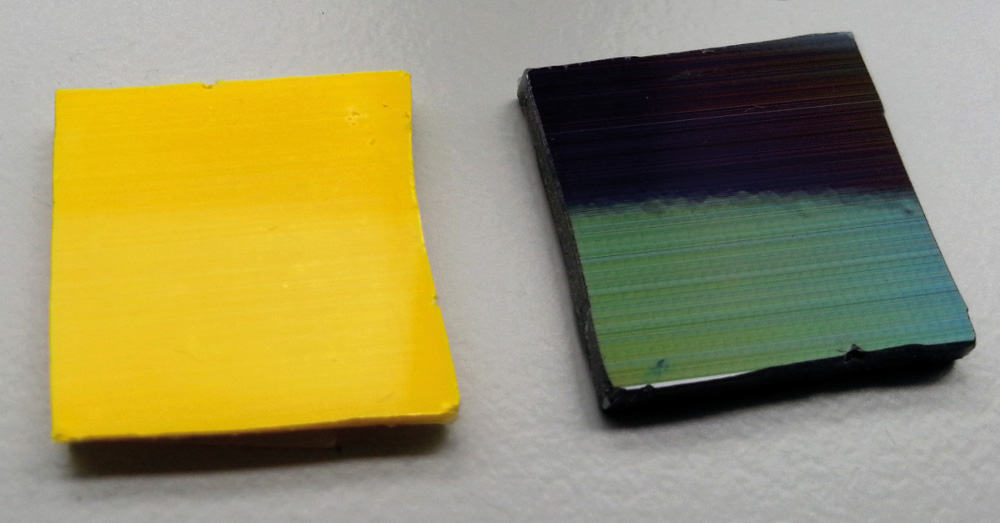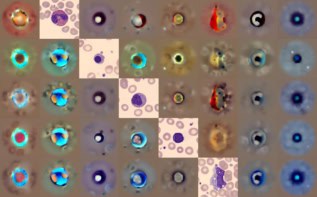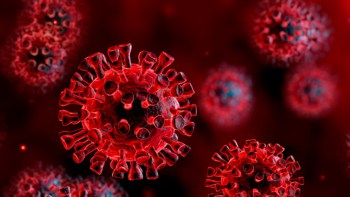When it comes to shapes and colours, flowers are one of nature’s most praised objects – but there is more to them than meets the eye. Tobias Wenzel and Silvia Vignolini reveal an ingenious strategy flowers use to become coloured and attract pollinators

Have you ever wondered why some butterflies and fruits can shine with a metallic, iridescent blue and beetles can decorate themselves with golden shells – but there is no paint that lets you depict these dynamic colours directly? Well, it all comes down to how those organisms create the colour.
Paints and pigments simply absorb part of the visible light spectrum and reflect the rest to create the colour we see – white if they reflect all the visible light, black if no reflection occurs, and other colours when only part of the spectrum is reflected. The special vibrant colours of the butterflies and beetles, in contrast, are obtained thanks to transparent materials that have nanoscale structures. As these features are similar in size to the wavelength of light, they can interact with it to create what are known as “structural colours” (Rep. Prog. Phys. 71 076401).
Many birds, insects, reptiles, bacteria and even mammals display an incredible variety of structural colours, which may be dynamic, unique and brighter than standard pigmentation. As Isaac Newton had suspected, the bright colours displayed by a peacock, for example, are structure based and cannot be achieved by paint-like pigmentation. Plants can create structural colours too, even though they have received far less scientific attention than animals. Indeed, structural colour can be found in everything from flowers and ferns to fruit, leaves and even seaweeds.
In addition to extending the available range and brightness of colours beyond those created by pigmentation, structural colours can offer further advantages to biological organisms as they can be easily tuned and adapted. Pigments have to be specially synthesized by an organism, requiring advanced chemistry, many genes and a lot of energy. In contrast, many structural colours are formed from more abundant materials, such as cell-wall cellulose or wax. This can be a huge evolutionary benefit, being easier to evolve and to adapt, as well as being “cheaper” to make. Indeed, structural colour can be altered by only changing the size of the structures producing them (PNAS 109 15712).
Floral striations

Some flower petals have a particularly interesting example of colour-generating nanostructures. Known as striations, these are parallel surface wrinkles in the petals’ cuticle – the upper wax layer of flowers – and are created when directional growth of the underlying plant cells causes a petal’s surface to physically wrinkle (J. R. Soc. Interface 10 20120847). Striations are tiny – barely a few hundred nanometres or 100 times smaller than the diameter of a human hair. Structures on this length scale are similar in size to the wavelength of visible light and therefore they interact with it, causing interference. The interaction is a partial reflection of light at the material interface, caused by light travelling at different speeds when propagating through materials with different optical densities (such as air, water, wax or cellulose). The distance between points where light is reflected determines how light interferes with itself. In particular, the spacing between structure elements dictates which colours are reflected (constructive interference), and which are not (destructive interference).
If floral striations are approximated to a periodic structure, they resemble a diffraction grating (see figure 1). In the first study describing striations, researchers observed a weakly iridescent appearance in a hibiscus and a tulip species, which is typical for relatively ordered gratings (Science 323 130). In nature, however, even surface structures that exhibit local order are inherently disordered to some degree. This disorder is seen, for example, in Morpho butterfly wings, where it widens the angular range of the colouration, making the effect visible from more perspectives. Apart from this benefit, however, disorder in (semi-)periodic structures is often seen as an unfortunate and inevitable effect in nature rather than a functional feature.
It’s in the detail
But when our team at the University of Cambridge assessed the role of natural disorder in a dozen flower species with surface striations, we were in for a surprise. We first had to find the flowers with structural colour, which we did by looking at a large number of flowers optically and then with electron microscopy for viewing-angle-dependent coloration (which is evidence for structural colour). The flowers were each selected to be from a different flower family, so they would be only distantly related and span the very large family tree of flowering plants.

Rocket for rocketeers
Although we first found that the variation in striation size and spacing reduced the rainbow-iridescence drastically, it also gave rise to an unexpected and new optical effect (Nature 550 469). While common diffraction gratings reflect all colours relatively equally, but at different angles, the semi-periodic striations on flowers preferably reflect shorter wavelengths (ultraviolet and blue light) in a much wider and more consistent range of directions (at the scattering angle range between about –25 and +25 degrees). We’ve called this optical effect the “blue halo”.
Using computer simulations, we were able to examine different parameters and look at the effects of different feature sizes on this optical halo. Artificially nanostructured samples – made by electron beam lithography and high-resolution flexible mould-based replication – allowed us to confirm the simulation predictions and mimic the optical response of real flowers, while (importantly) making the system less complex. As flowers have so many unique aspects to them, we could not have designed a fair bee-behaviour experiment with real flower samples – the replication method allowed us to make clearly distinct samples that vary only in structuration.
Interestingly, for the different plants analysed, a very similar optical effect was found, despite the height, width and spacing of the striations varying by about a quarter of their size within a flower, and by more than a factor of two between species. Since organization in biological materials is variable, the robustness of the optical effect makes semi-ordered striations particularly useful to achieve a reliable colouration. It also suggests that the amount of disorder in flowers is not random but optimized to some degree. The disorder in floral striations is therefore a functional feature, not a limiting legacy of the structure.
Hidden beauties

When flowers display a blue halo on a dark-pigmented region, the disordered nanostructure looks blue to the human eye (figure 2) as we cannot see ultraviolet light. The dark underlying layer absorbs the light not reflected by the structure, boosting the contrast and visibility of the structural colour.
Our team was able to identify a dozen very different flowers that had striations, and they all displayed this blue halo effect. However, the structural colour of many of these flowers was hidden from us for a long time, for some because the effect is in the ultraviolet region, which we cannot see, and the underlying pigment does not provide a good contrast to the structural colour. Indeed, in most flowers, bright yellow or red pigment makes it difficult to observe the blue at all.
Of course, the bright colours of flowers have not evolved because they look pretty in a vase on the dinner table. It is irrelevant for flowers whether we humans can see their blue halo or not, but it is vital for most to attract bees because they pollinate flowers and thus secure the plants’ reproduction and evolution.
Bees and bumblebees have a different visual system from humans and therefore they see different colours. For example, instead of the human receptor that enables us to see red colour, bees see ultraviolet light (along with blue and green, which humans also see). By performing behavioural experiments with bees and artificially nanostructured samples that mimic flowers with and without disorder, our collaborators at Cambridge and the Royal Botanic Gardens in Kew, UK, found that bumblebees could see the blue halo well on different coloured backgrounds and identify it quickly. And judging from learning curves and identification speeds, the bees see the optical effect better when the structure is disordered.
The ultraviolet-blue reflectance from striations could therefore be an important evolutionary contribution to the appearance of flowers, especially considering that the plant leaves in the background of flowers are already green (the other colour bees can see), and that blue tends to be a colour that is very difficult to synthesize for most plants.
Multipurpose striations

In addition to creating colour, floral striations are likely to have other functions too. Those could include tactile “touch-and-feel” indications for pollinating insects and self-cleaning properties caused by the striations’ enhanced water-repelling properties. Surface striations have also been found in animals, such as beetles, spiders and snakes, where they are likely to perform different functions than in flowers, such as distracting a predator or finding mates.
Our adventure into the details of nanostructures and flower colours has reminded us that we can learn surprising and fascinating engineering principles by looking at examples in nature. The ways in which biological cells produce and organize material sustainably at the nanoscale provides valuable insights to address a number of current challenges in science, technology and everyday life. Nanostructured materials are already used in a wide range of consumer products for manufacturing purposes or device functions, such as sensors that are as sensitive as moth antennae, swimsuits that glide through water as smoothly as sharks do, and surfaces that self-clean away dirt and water just like lotus leaves. Nanoparticles are now used in biology and industry alike to reduce the energy consumption and heat required to form materials.
Could disorder in nanotechnological products provide new functionalities that improve our lives? We might not see biomimetic striations in consumer products any time soon, but the new perspective to obtain functionality from the semi-random variation in nanostructures might inspire future innovation.



